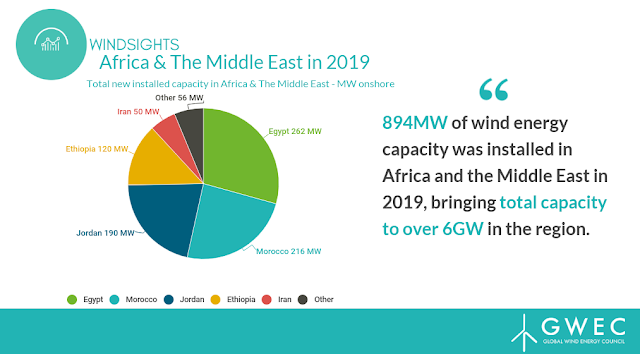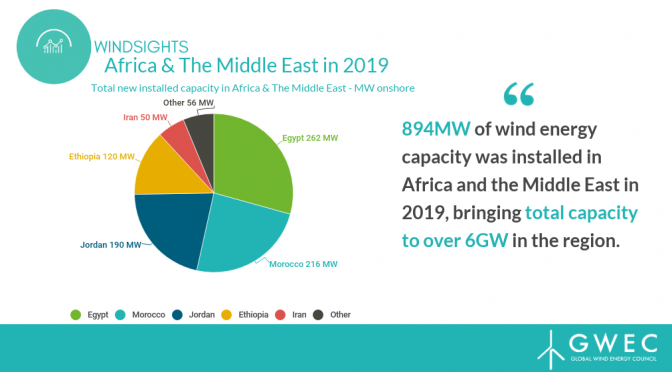Africa and the Middle East installed 894MW of wind energy capacity in 2019, a decrease of 7 per cent compared to installations in 2018. Total installed wind power capacity in Africa and the Middle East is now over 6GW.

Wind turbines capacity is expected to surge by 10,732MW over next five years, driven by wind farm installations in South Africa (3,3GW), Egypt (1,8GW), Morocco (1,2GW) and Saudi Arabia (1,2GW).
Wind energy in Africa and the Middle East will be a key technology to produce cost-competitive, sustainable energy, transform the region’s energy system to ensure access to modern electricity for all, create skilled jobs and drive local economic growth.
The latest data released by the Global Wind Energy Council (GWEC) shows Africa and the Middle East installed 894MW capacity of wind power in 2019, a decrease of 7 per cent on the previous year which saw 962MW installed. However, faster growth is on the horizon with GWEC Market Intelligence’s preliminary forecasts expecting 10.7GW of wind energy capacity to be installed between 2020-2024, an increase of 167% on current market status.
In 2019, the leading countries in the region for wind power capacity include:
- Egypt (262MW)
- Morocco (216 MW)
- Jordan (190MW)
- Ethiopia (120MW)
Over the next five years, South Africa will be leading the growth trend in the region with an additional 3.3GW of wind energy capacity installed by 2024. This wind turbines capacity will come from over 1.3GW of Bid Window 4 wind farm projects currently under construction as well further tenders in the context of the new Integrated Resource Plan (IRP) 2019, which foresees the installation of 14.4GW of wind power capacity from 2022-2030 in the country.
Considering other countries in Sub-Saharan Africa, the significant potential for wind energy remains clear, with the SADC region alone accounting for 18GW of wind energy potential in emerging markets such as Zambia, Tanzania, Namibia, and Mozambique.
In North Africa and the Middle East, GWEC foresees a major acceleration in growth in the next few years as a maturing project pipeline will come into place in 2020 to support an increase in wind power capacity, with GWEC Market Intelligence preliminary forecasts showing that wind energy capacity will surge over the next five years in markets such as Egypt (1.8GW), Morocco (1.2GW) and Saudi Arabia (1.2GW).
Jon Lezamiz, African Market Development Director at Siemens Gamesa and Chair of GWEC’s Africa Task Force commented: “Africa and the Middle East are endowed with fantastic wind resources, and the industry is committed to supporting policymakers in the region to reap the benefits wind power can provide for their energy systems and economy. In those countries with proper frameworks and stable bankable pipelines, we are already seeing a local supply chain being developed, such as Siemens Gamesa’s blade factory in Morocco, to meet wind energy demand increases while providing local jobs to build a long-term industry and economic opportunity in the region. We see many exciting developments in the region including construction starting on hybrid renewable projects, increases in regional cooperation and opening of markets to corporate PPAs, all of which we are convinced will drive growth in the coming years. However, as unlocking the full potential of the wind sector has not yet been encompassed and electricity demand continues to grow, we at GWEC are ready to support governments and key stakeholders to create the appropriate frameworks that would fix the adequate pace and, thus, create a visible long-term, stable bankable project pipeline”.
Ben Backwell, CEO of GWEC said: “Challenges such as policy and power market frameworks, transmission infrastructure bottlenecks, and off-taker risk must be overcome in order for Africa and the Middle East to take full advantage of their wind potential. GWEC has published the Africa Wind Energy Handbook as a tool to support policymakers in the region to overcome these challenges, bringing together the knowledge and experience of the industry to apply to the unique contexts of each market in the region. This will be crucial as the region’s energy demands, GDP and population are set to grow significantly over the next decade, as wind can provide a decentralised, cheap and reliable energy source to increase electrification rates and support this growth”.


